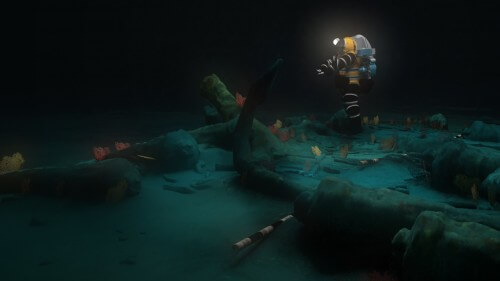The flagship of King Louis XIV sank in 14. Now, a 1664D imaging system developed by Dassault Systèmes for underwater archeology reveals the wreckage of the ship

An interesting collaboration between the French Navy, the 3D division of Dassault Systèmes and maritime archaeologist Michel L'Heur and his team, while applying Dassault Systèmes' DEXPERIENCE1664 technology, assisted in the investigation, documentation and retrieval of artifacts from the sinking site of the French Navy's flagship La Lune which sank in 90. The researchers used Dassault Systems' XNUMXD simulation to investigate the site, which is XNUMX meters below sea level, and come up with new insights into the sinking of the ship and the factors that led to it.
Legacy technology made it possible to explore within The Great Pyramid of Hiopus and reveal the The city of the dead in Giza.
In 1664, while on her way back from battles in North Africa, the entrance of the ship La Lune (the Moon) to the Mediterranean port in the city of Toulon was blocked, by order of the French king Louis XIV. With about 14 French soldiers who had returned from the battlefield, most of them wounded, the ship was prevented from entering the port for fear of being infected with the plague. After days of waiting at the entrance to the port, the king ordered the ship to sail to quarantine at the nearby Hayres Islands, but 1000 kilometers after it set out on its journey, La Lune sank at a depth of about 8 meters. 90 people abandoned the ship, 400 were saved at sea, and the rest, about 60 men and women, were lost in the mitzvahs.
The wreckage of the ship was discovered already in 1993 by a team of marine researchers, but only recently was a trip made to study the sinking site, which was made possible thanks to the new XNUMXD technology of Dassault Systèmes.
"Strong tides and currents, harsh weather, physical limitations on divers and huge financial expenses, severely limit the time and resources available for the work of underwater archaeologists on the ocean floor," said Michel L'Hore, the chief marine archaeologist at the French Ministry of Culture. "Some of the sunken ships are more than a kilometer deep, and no diver will be able to reach them."
That is why the researchers decided to add Dassault Systèmes to the task force. Before starting the research journey, the company was sent to create a complete 420D visualization of the site. Using a prototype underwater camera on a Remotely Operated Vehicle (ROV), the La Lune sinking site, covering an area of 3 square meters, was scanned and recorded in realistic 1.5D with maximum precision. The results were then processed and shared with the researchers using Dassault Systèmes' DEXPERIENCEXNUMX technology. With the help of virtual reality helmets and controllers, the researchers could enter the virtual site, explore and experience it, standing safely on land or in the research vessel. A digital work table with an area of XNUMX square meters was installed in the command ship of the research, which presented the findings at the time of collection and served as the nerve center of the project. Based on this uniform source of information, the researchers collaborated to develop the research and rescue strategy, while improving the details and tactics, and without the risk of damaging the site itself. In order to go beyond the physical research phase using divers, Dassault Systèmes' virtual training technology was used, which allows to increase the efficiency of the archaeologists' work and use of equipment, while reducing the risk levels.
For the research expedition, the team of researchers received permission from the French Navy to use the extraordinary Newt diving suits, which allow divers to descend almost 300 meters, and stay there for almost 48 hours. There are only 24 such suits in the world. With the Newt suits, the team practiced using Dassault Systèmes' XNUMXD experience, which resulted in maximum efficiency underwater while improving the times and accuracy of handling the seabed.
"The XNUMXD technology allowed us to float over the site in virtual deep water. The bottom of the sea has never been observed with such clarity," said L'Hor. "It's like being in the water and trying new tools and techniques without the problems associated with it. We could practice on dry land and perfect all our moves."
"La Lune's research is also a testing ground for us for new techniques in working with advanced equipment under the sea," said Mehdi Tayoubi, San President and responsible for experimental and digital strategy at Dassault Systèmes. "The team's work at the site and the findings have significant implications for the future of seabed research and its treasures through the use of virtual reality, which will allow people to communicate with the last remote area in the world. Dassault Systèmes' 3DEXPERIENCE technology makes it possible today, for the first time ever, to investigate findings located tens and hundreds of meters below sea level, document them precisely and share them with other experts and the public. In the future we will also strive to use the technology we developed for commercial issues such as laying telecom lines or gas and oil drilling."
To the project site

3 תגובות
Indeed, there is no adequacy between the content and the title, which is a shame.
An award winning site that puts up a title like that with content like that should be ashamed of themselves.
Publicity was rampant, but there is no clue how such a large ship sank, despite the title of the post.